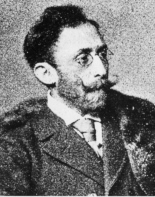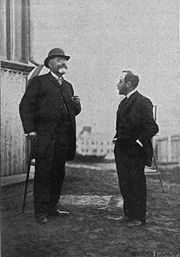
Arthur Berson
Encyclopedia

Poles
thumb|right|180px|The state flag of [[Poland]] as used by Polish government and diplomatic authoritiesThe Polish people, or Poles , are a nation indigenous to Poland. They are united by the Polish language, which belongs to the historical Lechitic subgroup of West Slavic languages of Central Europe...
meteorologist and pioneer of aerology who was a native of Neu Sandez, Galicia (now Nowy Sącz
Nowy Sacz
Nowy Sącz is a town in the Lesser Poland Voivodeship in southern Poland. It is the district capital of Nowy Sącz County, but is not included within the powiat.-Names:...
, Poland
Poland
Poland , officially the Republic of Poland , is a country in Central Europe bordered by Germany to the west; the Czech Republic and Slovakia to the south; Ukraine, Belarus and Lithuania to the east; and the Baltic Sea and Kaliningrad Oblast, a Russian exclave, to the north...
).
After visiting the gymnasium
Gymnasium (school)
A gymnasium is a type of school providing secondary education in some parts of Europe, comparable to English grammar schools or sixth form colleges and U.S. college preparatory high schools. The word γυμνάσιον was used in Ancient Greece, meaning a locality for both physical and intellectual...
in Neu Sandez Berson studied philology
Philology
Philology is the study of language in written historical sources; it is a combination of literary studies, history and linguistics.Classical philology is the philology of Greek and Classical Latin...
in Vienna
University of Vienna
The University of Vienna is a public university located in Vienna, Austria. It was founded by Duke Rudolph IV in 1365 and is the oldest university in the German-speaking world...
. He then studied meteorology
Meteorology
Meteorology is the interdisciplinary scientific study of the atmosphere. Studies in the field stretch back millennia, though significant progress in meteorology did not occur until the 18th century. The 19th century saw breakthroughs occur after observing networks developed across several countries...
and geography
Geography
Geography is the science that studies the lands, features, inhabitants, and phenomena of Earth. A literal translation would be "to describe or write about the Earth". The first person to use the word "geography" was Eratosthenes...
in Berlin
Humboldt University of Berlin
The Humboldt University of Berlin is Berlin's oldest university, founded in 1810 as the University of Berlin by the liberal Prussian educational reformer and linguist Wilhelm von Humboldt, whose university model has strongly influenced other European and Western universities...
, where he had as instructors Ferdinand von Richthofen
Ferdinand von Richthofen
Ferdinand Freiherr von Richthofen was a German traveller, geographer, and scientist.-Biography:He was born in Carlsruhe, Prussian Silesia, and was educated in Breslau and Berlin. He traveled or studied in the Alps of Tyrol and the Carpathians in Transylvania...
and Wilhelm von Bezold
Wilhelm von Bezold
Johann Friedrich Wilhelm von Bezold was a German physicist and meteorologist born in Munich, Kingdom of Bavaria....
. In 1890 he was an assistant to meteorologist Richard Aßmann
Richard Assmann
Richard Assmann ; was a German meteorologist and physician who was a native of Magdeburg....
at the Meteorological Institute in Berlin. During this period of time he was also secretary of the Deutschen Verein zur Förderung der Luftschiffahrt, the first aeronautical
Aeronautics
Aeronautics is the science involved with the study, design, and manufacturing of airflight-capable machines, or the techniques of operating aircraft and rocketry within the atmosphere...
organization in Germany. In 1900 he became Hauptobservator at the newly founded Aeronautics Observatory in Berlin-Tegel
Tegel
Tegel is a locality in the Berlin borough of Reinickendorf on the shore of Lake Tegel. The Tegel locality, the second largest in area of the 95 Berlin districts, also includes the neighbourhood of Saatwinkel.-History:...
, and was later stationed at the Lindenberg Aeronautical Observatory in Beeskow
Beeskow
Beeskow is a town in Brandenburg, Germany, and capital of the Oder-Spree district. It is situated on the river Spree, 30 km southwest of Frankfurt an der Oder....
. From 1896 to 1899 Berson was editor of the magazine Zeitschrift für Luftfahrt und Physik der Atmosphäre (Magazine for Aviation and Physics of the Atmosphere).
Berson is largely known for his scientific hot-air balloon expeditions. On 4 December 1894 he ascended to a then-record altitude of 9,155 meters aboard the hydrogen balloon Phoenix. On 10 January 1901, with artillery officer Alfred Hildebrandt (1870–1949), he travelled from Berlin to Markaryd
Markaryd
Markaryd is a locality and the seat of Markaryd Municipality, Kronoberg County, Sweden with 3,826 inhabitants in 2005.- References :...
, Sweden in a balloon, thus being the first to cross the Baltic Sea
Baltic Sea
The Baltic Sea is a brackish mediterranean sea located in Northern Europe, from 53°N to 66°N latitude and from 20°E to 26°E longitude. It is bounded by the Scandinavian Peninsula, the mainland of Europe, and the Danish islands. It drains into the Kattegat by way of the Øresund, the Great Belt and...
by air. On January 10, 1902 with balloonist Hermann Elias (1876–1955), he set the German long-distance ballooning record, as the two men journeyed from Berlin to Poltava
Poltava
Poltava is a city in located on the Vorskla River in central Ukraine. It is the administrative center of the Poltava Oblast , as well as the surrounding Poltava Raion of the oblast. Poltava's estimated population is 298,652 ....
in the central Ukraine (1,470 kilometers in 30 hours).
During the 1890s he was involved in international "simultaneous ascents" with balloonists from other nations. These ascents were performed in order to study variances of climatic
Climate
Climate encompasses the statistics of temperature, humidity, atmospheric pressure, wind, rainfall, atmospheric particle count and other meteorological elemental measurements in a given region over long periods...
conditions above different locations in Europe, to work to bring about uniformity in methods of observation, and to create increased cooperation among nations in the new science of aerology.

Reinhard Süring
Reinhard Süring was a German meteorologist who was a native of Hamburg. He died in Potsdam, East Germany on 29 December 1950....
, he took his most celebrated ascent. Starting from Berlin-Tempelhof
Tempelhof
Tempelhof is a locality of Berlin within the borough of Tempelhof-Schöneberg. It is the location of the former Tempelhof Airport, one of the earliest commercial airports in the world. It is now deserted and shows as a blank spot on maps of Berlin. Attempts are being made to save the still-existing...
aboard the Preussen, Berson and Süring ultimately reached a height of 10,800 meters above sea level
Sea level
Mean sea level is a measure of the average height of the ocean's surface ; used as a standard in reckoning land elevation...
. At 6000 m. they required compressed oxygen, at 10,000 m. both scientists were rendered unconscious, and after regaining consciousness were able to land their balloon near Briesen, 7.5 hours after their flight began. Their record ascent also had significant scientific importance. Climatic data taken from simultaneously released unmanned sounding
Atmospheric sounding
An atmospheric sounding is a measurement of vertical distribution of physical properties of the atmospheric column such as pressure, temperature, wind speed and wind direction , liquid water content, ozone concentration, pollution, and other properties...
balloons agreed with the information gathered from the Berson/Süring ascent. Now scientists such as Richard Aßmann no longer had any reason to distrust temperature readings taken from unmanned balloons, which was an important factor that led to the discovery of the stratosphere
Stratosphere
The stratosphere is the second major layer of Earth's atmosphere, just above the troposphere, and below the mesosphere. It is stratified in temperature, with warmer layers higher up and cooler layers farther down. This is in contrast to the troposphere near the Earth's surface, which is cooler...
by Aßmann and Teisserenc de Bort in 1902.
Another important aspect of high altitude flight involved physiological
Physiology
Physiology is the science of the function of living systems. This includes how organisms, organ systems, organs, cells, and bio-molecules carry out the chemical or physical functions that exist in a living system. The highest honor awarded in physiology is the Nobel Prize in Physiology or...
problems that balloonists would experience when exposed to conditions at great heights, and Berson assisted physiologists Hermann von Schrötter
Hermann von Schrötter
Anton Hermann Victor Thomas Schrötter, name sometimes referred to as Hermann Schrötter von Kristelli was an Austrian physiologist and physician who was a native of Vienna...
and Nathan Zuntz
Nathan Zuntz
Nathan Zuntz was a German physiologist born in Bonn. He was a pioneer of modern altitude physiology and aviation medicine.- Academic career :...
with pioneer experiments in aviation medicine
Aviation medicine
Aviation medicine, also called flight medicine or aerospace medicine, is a preventive or occupational medicine in which the patients/subjects are pilots, aircrews, or persons involved in spaceflight...
. This involved high altitude balloon ascents with the two physiologists, and extensive studies of decompression sickness
Decompression sickness
Decompression sickness describes a condition arising from dissolved gases coming out of solution into bubbles inside the body on depressurization...
done with a pneumatic chamber located at the Jüdischen Krankenhaus (Jewish Hospital) in Berlin.
Other significant accomplishments by Berson included climatic studies with weather kites off of Svalbard
Svalbard
Svalbard is an archipelago in the Arctic, constituting the northernmost part of Norway. It is located north of mainland Europe, midway between mainland Norway and the North Pole. The group of islands range from 74° to 81° north latitude , and from 10° to 35° east longitude. Spitsbergen is the...
, pioneer meteorological observations from German East Africa
German East Africa
German East Africa was a German colony in East Africa, which included what are now :Burundi, :Rwanda and Tanganyika . Its area was , nearly three times the size of Germany today....
, and aerological research over the Amazon Basin
Amazon Basin
The Amazon Basin is the part of South America drained by the Amazon River and its tributaries that drains an area of about , or roughly 40 percent of South America. The basin is located in the countries of Bolivia, Brazil, Colombia, Ecuador, Guyana, Peru, and Venezuela...
.

